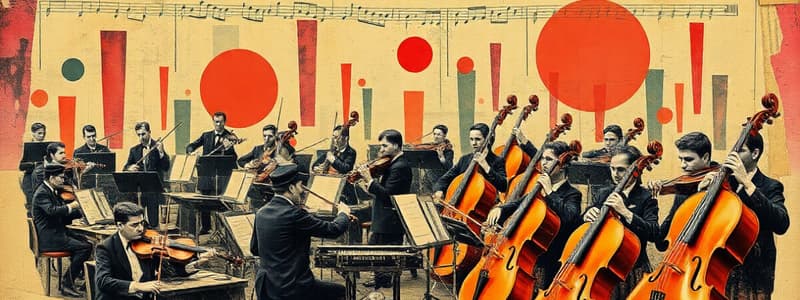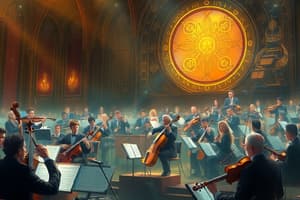Podcast
Questions and Answers
Which of the following instruments belongs to the woodwind family?
Which of the following instruments belongs to the woodwind family?
- Violin
- Bass clarinet (correct)
- Cymbals
- French horn
What is the smallest instrument in the string family?
What is the smallest instrument in the string family?
- Viola
- Violin (correct)
- Cello
- Double bass
Which instrument can function both as a solo and orchestral instrument?
Which instrument can function both as a solo and orchestral instrument?
- Bass drum
- Grand piano (correct)
- Piccolo
- Triangle
How many instrumentalists usually comprise an orchestra?
How many instrumentalists usually comprise an orchestra?
Which of these instruments is NOT part of the percussion section?
Which of these instruments is NOT part of the percussion section?
How do string instruments produce sound?
How do string instruments produce sound?
Flashcards
Orchestra
Orchestra
A large group of musicians playing together on various instruments, typically 70-100 members.
Percussion Instruments
Percussion Instruments
Instruments that produce sound by being struck, including drums and cymbals.
Brass Instruments
Brass Instruments
Musical instruments made of brass, such as French horns, that produce sound by buzzing lips into a mouthpiece.
Woodwind Instruments
Woodwind Instruments
Signup and view all the flashcards
String Section
String Section
Signup and view all the flashcards
Grand Piano in Orchestra
Grand Piano in Orchestra
Signup and view all the flashcards
Study Notes
Symphony Orchestra
- An orchestra is a large group of musicians playing together
- The number of musicians can range from 70 to 100, dependent on the chosen music
- Orchestras evolved gradually from 17th-century court bands
- New instruments and improvements were added gradually
- By 1830, the typical symphony orchestra was complete
Instruments
- Woodwinds: Include flutes, clarinets, bassoons, and piccolo
- Brass: Include French horns, trumpets, trombones, and tubas
- Percussion: Include drums, cymbals, triangle, and tambourines
- Strings: Include violins, violas, cellos, and double basses
String Section
- String instruments produce sound through vibrating strings
- Instruments vary in size, ranging from violins to double basses
Studying That Suits You
Use AI to generate personalized quizzes and flashcards to suit your learning preferences.





